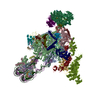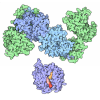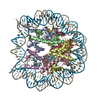+ Open data
Open data
- Basic information
Basic information
| Entry | Database: PDB / ID: 7unc | ||||||
|---|---|---|---|---|---|---|---|
| Title | Pol II-DSIF-SPT6-PAF1c-TFIIS complex with rewrapped nucleosome | ||||||
 Components Components |
| ||||||
 Keywords Keywords | TRANSCRIPTION / Chromatin / nucleosome / intermediate | ||||||
| Function / homology |  Function and homology information Function and homology informationblastocyst growth / Ski complex / mRNA decay by 3' to 5' exoribonuclease / RNA polymerase II C-terminal domain phosphoserine binding / inner cell mass cell differentiation / positive regulation of mRNA 3'-end processing / regulation of isotype switching / Cdc73/Paf1 complex / nuclear-transcribed mRNA catabolic process, 3'-5' exonucleolytic nonsense-mediated decay / negative regulation of DNA-templated transcription, elongation ...blastocyst growth / Ski complex / mRNA decay by 3' to 5' exoribonuclease / RNA polymerase II C-terminal domain phosphoserine binding / inner cell mass cell differentiation / positive regulation of mRNA 3'-end processing / regulation of isotype switching / Cdc73/Paf1 complex / nuclear-transcribed mRNA catabolic process, 3'-5' exonucleolytic nonsense-mediated decay / negative regulation of DNA-templated transcription, elongation / regulation of muscle cell differentiation / endodermal cell fate commitment / negative regulation of myeloid cell differentiation / positive regulation of cell cycle G1/S phase transition / DSIF complex / trophectodermal cell differentiation / regulation of transcription elongation by RNA polymerase II / blastocyst hatching / nucleosome organization / blastocyst formation / mRNA 3'-end processing / positive regulation of DNA-templated transcription, elongation / Abortive elongation of HIV-1 transcript in the absence of Tat / transcription factor TFIID complex / transcription elongation-coupled chromatin remodeling / interleukin-6-mediated signaling pathway / stem cell population maintenance / negative regulation of G1/S transition of mitotic cell cycle / negative regulation of gene expression, epigenetic / RNA Pol II CTD phosphorylation and interaction with CE during HIV infection / RNA Pol II CTD phosphorylation and interaction with CE / Formation of the Early Elongation Complex / Formation of the HIV-1 Early Elongation Complex / mRNA Capping / RNA polymerase II complex binding / Pausing and recovery of Tat-mediated HIV elongation / Tat-mediated HIV elongation arrest and recovery / positive regulation of macroautophagy / RNA polymerase II transcribes snRNA genes / HIV elongation arrest and recovery / Pausing and recovery of HIV elongation / cell surface receptor signaling pathway via JAK-STAT / protein localization to nucleus / mRNA transport / positive regulation of Wnt signaling pathway / Tat-mediated elongation of the HIV-1 transcript / Formation of HIV-1 elongation complex containing HIV-1 Tat / negative regulation of fibroblast proliferation / RNA polymerase I complex / RNA polymerase III complex / Formation of HIV elongation complex in the absence of HIV Tat / tRNA transcription by RNA polymerase III / RNA polymerase II, core complex / nucleosome binding / transcription by RNA polymerase I / RNA Polymerase II Transcription Elongation / Formation of RNA Pol II elongation complex / RNA Polymerase II Pre-transcription Events / rescue of stalled cytosolic ribosome / DNA-directed RNA polymerase complex / SH2 domain binding / RNA splicing / transcription elongation factor complex / erythrocyte differentiation / TP53 Regulates Transcription of DNA Repair Genes / regulation of cell growth / transcription elongation by RNA polymerase II / DNA-templated transcription initiation / positive regulation of transcription elongation by RNA polymerase II / euchromatin / Formation of the beta-catenin:TCF transactivating complex / Hedgehog 'on' state / protein destabilization / Transcription-Coupled Nucleotide Excision Repair (TC-NER) / ribonucleoside binding / Formation of TC-NER Pre-Incision Complex / fibrillar center / Wnt signaling pathway / mRNA processing / negative regulation of epithelial cell proliferation / DNA-directed RNA polymerase / Dual incision in TC-NER / Gap-filling DNA repair synthesis and ligation in TC-NER / structural constituent of chromatin / DNA-directed RNA polymerase activity / heterochromatin formation / nucleosome / nucleosome assembly / single-stranded DNA binding / E3 ubiquitin ligases ubiquitinate target proteins / chromosome / cellular response to lipopolysaccharide / chromatin organization / histone binding / nucleic acid binding / transcription by RNA polymerase II / chromosome, telomeric region / protein dimerization activity / nuclear speck / hydrolase activity Similarity search - Function | ||||||
| Biological species |  Homo sapiens (human) Homo sapiens (human) synthetic construct (others) | ||||||
| Method | ELECTRON MICROSCOPY / single particle reconstruction / cryo EM / Resolution: 3 Å | ||||||
 Authors Authors | Filipovski, M. / Vos, S.M. / Farnung, L. | ||||||
| Funding support |  United States, 1items United States, 1items
| ||||||
 Citation Citation |  Journal: Science / Year: 2022 Journal: Science / Year: 2022Title: Structural basis of nucleosome retention during transcription elongation. Authors: Martin Filipovski / Jelly H M Soffers / Seychelle M Vos / Lucas Farnung /  Abstract: In eukaryotes, RNA polymerase (Pol) II transcribes chromatin and must move past nucleosomes, often resulting in nucleosome displacement. How Pol II unwraps the DNA from nucleosomes to allow ...In eukaryotes, RNA polymerase (Pol) II transcribes chromatin and must move past nucleosomes, often resulting in nucleosome displacement. How Pol II unwraps the DNA from nucleosomes to allow transcription and how DNA rewraps to retain nucleosomes has been unclear. Here, we report the 3.0-angstrom cryo-electron microscopy structure of a mammalian Pol II-DSIF-SPT6-PAF1c-TFIIS-nucleosome complex stalled 54 base pairs within the nucleosome. The structure provides a mechanistic basis for nucleosome retention during transcription elongation where upstream DNA emerging from the Pol II cleft has rewrapped the proximal side of the nucleosome. The structure uncovers a direct role for Pol II and transcription elongation factors in nucleosome retention and explains how nucleosomes are retained to prevent the disruption of chromatin structure across actively transcribed genes. | ||||||
| History |
|
- Structure visualization
Structure visualization
| Structure viewer | Molecule:  Molmil Molmil Jmol/JSmol Jmol/JSmol |
|---|
- Downloads & links
Downloads & links
- Download
Download
| PDBx/mmCIF format |  7unc.cif.gz 7unc.cif.gz | 2.4 MB | Display |  PDBx/mmCIF format PDBx/mmCIF format |
|---|---|---|---|---|
| PDB format |  pdb7unc.ent.gz pdb7unc.ent.gz | Display |  PDB format PDB format | |
| PDBx/mmJSON format |  7unc.json.gz 7unc.json.gz | Tree view |  PDBx/mmJSON format PDBx/mmJSON format | |
| Others |  Other downloads Other downloads |
-Validation report
| Summary document |  7unc_validation.pdf.gz 7unc_validation.pdf.gz | 1.1 MB | Display |  wwPDB validaton report wwPDB validaton report |
|---|---|---|---|---|
| Full document |  7unc_full_validation.pdf.gz 7unc_full_validation.pdf.gz | 1.2 MB | Display | |
| Data in XML |  7unc_validation.xml.gz 7unc_validation.xml.gz | 177.5 KB | Display | |
| Data in CIF |  7unc_validation.cif.gz 7unc_validation.cif.gz | 301.9 KB | Display | |
| Arichive directory |  https://data.pdbj.org/pub/pdb/validation_reports/un/7unc https://data.pdbj.org/pub/pdb/validation_reports/un/7unc ftp://data.pdbj.org/pub/pdb/validation_reports/un/7unc ftp://data.pdbj.org/pub/pdb/validation_reports/un/7unc | HTTPS FTP |
-Related structure data
| Related structure data |  26620MC  7undC M: map data used to model this data C: citing same article ( |
|---|---|
| Similar structure data | Similarity search - Function & homology  F&H Search F&H Search |
- Links
Links
- Assembly
Assembly
| Deposited unit | 
|
|---|---|
| 1 |
|
- Components
Components
-DNA-directed RNA polymerase ... , 5 types, 5 molecules ABCEG
| #1: Protein | Mass: 219049.500 Da / Num. of mol.: 1 / Source method: isolated from a natural source / Source: (natural)  References: UniProt: A0A7M4DUC2, DNA-directed RNA polymerase |
|---|---|
| #2: Protein | Mass: 142426.125 Da / Num. of mol.: 1 / Source method: isolated from a natural source / Source: (natural)  References: UniProt: A0A4X1TVZ5, DNA-directed RNA polymerase |
| #3: Protein | Mass: 31439.074 Da / Num. of mol.: 1 / Source method: isolated from a natural source / Source: (natural)  |
| #5: Protein | Mass: 24644.318 Da / Num. of mol.: 1 / Source method: isolated from a natural source / Source: (natural)  |
| #7: Protein | Mass: 19314.283 Da / Num. of mol.: 1 / Source method: isolated from a natural source / Source: (natural)  |
-Protein , 12 types, 16 molecules DFHIJKWXaebfcgdh
| #4: Protein | Mass: 20962.621 Da / Num. of mol.: 1 / Source method: isolated from a natural source / Source: (natural)  | ||||||
|---|---|---|---|---|---|---|---|
| #6: Protein | Mass: 14477.001 Da / Num. of mol.: 1 / Source method: isolated from a natural source / Source: (natural)  | ||||||
| #8: Protein | Mass: 17162.273 Da / Num. of mol.: 1 / Source method: isolated from a natural source / Source: (natural)  | ||||||
| #9: Protein | Mass: 14541.221 Da / Num. of mol.: 1 / Source method: isolated from a natural source / Source: (natural)  | ||||||
| #10: Protein | Mass: 7655.123 Da / Num. of mol.: 1 / Source method: isolated from a natural source / Source: (natural)  | ||||||
| #11: Protein | Mass: 13310.284 Da / Num. of mol.: 1 / Source method: isolated from a natural source / Source: (natural)  | ||||||
| #22: Protein | Mass: 33617.465 Da / Num. of mol.: 1 Source method: isolated from a genetically manipulated source Source: (gene. exp.)  Homo sapiens (human) / Production host: Homo sapiens (human) / Production host:  Trichoplusia ni (cabbage looper) / References: UniProt: Q9GZS3 Trichoplusia ni (cabbage looper) / References: UniProt: Q9GZS3 | ||||||
| #23: Protein | Mass: 60673.539 Da / Num. of mol.: 1 Source method: isolated from a genetically manipulated source Source: (gene. exp.)  Homo sapiens (human) / Gene: CDC73, C1orf28, HRPT2 / Production host: Homo sapiens (human) / Gene: CDC73, C1orf28, HRPT2 / Production host:  Trichoplusia ni (cabbage looper) / References: UniProt: Q6P1J9 Trichoplusia ni (cabbage looper) / References: UniProt: Q6P1J9 | ||||||
| #25: Protein | Mass: 15435.126 Da / Num. of mol.: 2 / Mutation: G102A Source method: isolated from a genetically manipulated source Source: (gene. exp.)  #26: Protein | Mass: 11394.426 Da / Num. of mol.: 2 Source method: isolated from a genetically manipulated source Source: (gene. exp.)  #27: Protein | Mass: 14109.436 Da / Num. of mol.: 2 Source method: isolated from a genetically manipulated source Source: (gene. exp.)  #28: Protein | Mass: 13655.948 Da / Num. of mol.: 2 / Mutation: S29T Source method: isolated from a genetically manipulated source Source: (gene. exp.)  |
-RNA polymerase ... , 2 types, 2 molecules LV
| #12: Protein | Mass: 7018.244 Da / Num. of mol.: 1 / Source method: isolated from a natural source / Source: (natural)  |
|---|---|
| #21: Protein | Mass: 60052.672 Da / Num. of mol.: 1 Source method: isolated from a genetically manipulated source Source: (gene. exp.)  Homo sapiens (human) / Gene: PAF1, PD2 / Production host: Homo sapiens (human) / Gene: PAF1, PD2 / Production host:  Trichoplusia ni (cabbage looper) / References: UniProt: Q8N7H5 Trichoplusia ni (cabbage looper) / References: UniProt: Q8N7H5 |
-Transcription elongation factor ... , 3 types, 3 molecules MOZ
| #13: Protein | Mass: 199602.969 Da / Num. of mol.: 1 Source method: isolated from a genetically manipulated source Source: (gene. exp.)  Homo sapiens (human) / Gene: SUPT6H, KIAA0162, SPT6H / Production host: Homo sapiens (human) / Gene: SUPT6H, KIAA0162, SPT6H / Production host:  Trichoplusia ni (cabbage looper) / References: UniProt: Q7KZ85 Trichoplusia ni (cabbage looper) / References: UniProt: Q7KZ85 |
|---|---|
| #15: Protein | Mass: 34294.980 Da / Num. of mol.: 1 Source method: isolated from a genetically manipulated source Source: (gene. exp.)  Homo sapiens (human) / Gene: TCEA1, GTF2S, TFIIS / Production host: Homo sapiens (human) / Gene: TCEA1, GTF2S, TFIIS / Production host:  |
| #24: Protein | Mass: 121225.477 Da / Num. of mol.: 1 Source method: isolated from a genetically manipulated source Source: (gene. exp.)  Homo sapiens (human) / Gene: SUPT5H, SPT5, SPT5H / Production host: Homo sapiens (human) / Gene: SUPT5H, SPT5, SPT5H / Production host:  Trichoplusia ni (cabbage looper) / References: UniProt: O00267 Trichoplusia ni (cabbage looper) / References: UniProt: O00267 |
-DNA chain , 2 types, 2 molecules NT
| #14: DNA chain | Mass: 64763.039 Da / Num. of mol.: 1 / Source method: obtained synthetically / Source: (synth.) synthetic construct (others) |
|---|---|
| #19: DNA chain | Mass: 66186.398 Da / Num. of mol.: 1 / Source method: obtained synthetically / Source: (synth.) synthetic construct (others) |
-RNA chain , 1 types, 1 molecules P
| #16: RNA chain | Mass: 5004.936 Da / Num. of mol.: 1 / Source method: obtained synthetically / Source: (synth.) synthetic construct (others) |
|---|
-RNA polymerase-associated protein ... , 3 types, 3 molecules QRU
| #17: Protein | Mass: 134510.203 Da / Num. of mol.: 1 Source method: isolated from a genetically manipulated source Source: (gene. exp.)  Homo sapiens (human) / Gene: CTR9, KIAA0155, SH2BP1 / Production host: Homo sapiens (human) / Gene: CTR9, KIAA0155, SH2BP1 / Production host:  Trichoplusia ni (cabbage looper) / References: UniProt: Q6PD62 Trichoplusia ni (cabbage looper) / References: UniProt: Q6PD62 |
|---|---|
| #18: Protein | Mass: 80733.016 Da / Num. of mol.: 1 Source method: isolated from a genetically manipulated source Source: (gene. exp.)  Homo sapiens (human) / Gene: RTF1, KIAA0252 / Production host: Homo sapiens (human) / Gene: RTF1, KIAA0252 / Production host:  Trichoplusia ni (cabbage looper) / References: UniProt: Q92541 Trichoplusia ni (cabbage looper) / References: UniProt: Q92541 |
| #20: Protein | Mass: 75514.172 Da / Num. of mol.: 1 Source method: isolated from a genetically manipulated source Source: (gene. exp.)  Homo sapiens (human) / Gene: LEO1, RDL / Production host: Homo sapiens (human) / Gene: LEO1, RDL / Production host:  Trichoplusia ni (cabbage looper) / References: UniProt: Q8WVC0 Trichoplusia ni (cabbage looper) / References: UniProt: Q8WVC0 |
-Non-polymers , 2 types, 9 molecules 


| #29: Chemical | ChemComp-ZN / #30: Chemical | ChemComp-MG / | |
|---|
-Details
| Has ligand of interest | N |
|---|---|
| Has protein modification | Y |
-Experimental details
-Experiment
| Experiment | Method: ELECTRON MICROSCOPY |
|---|---|
| EM experiment | Aggregation state: PARTICLE / 3D reconstruction method: single particle reconstruction |
- Sample preparation
Sample preparation
| Component | Name: Pol II-DSIF-SPT6-PAF1c-TFIIS complex with rewrapped nucleosome Type: COMPLEX / Entity ID: #1-#28 / Source: MULTIPLE SOURCES | ||||||||||||||||||||||||||||||
|---|---|---|---|---|---|---|---|---|---|---|---|---|---|---|---|---|---|---|---|---|---|---|---|---|---|---|---|---|---|---|---|
| Molecular weight | Experimental value: NO | ||||||||||||||||||||||||||||||
| Buffer solution | pH: 7.4 | ||||||||||||||||||||||||||||||
| Buffer component |
| ||||||||||||||||||||||||||||||
| Specimen | Embedding applied: NO / Shadowing applied: NO / Staining applied: NO / Vitrification applied: YES | ||||||||||||||||||||||||||||||
| Specimen support | Details: 15 mA with 10 s hold time / Grid material: COPPER / Grid mesh size: 200 divisions/in. / Grid type: Quantifoil R2/1 | ||||||||||||||||||||||||||||||
| Vitrification | Instrument: FEI VITROBOT MARK IV / Cryogen name: ETHANE / Humidity: 100 % / Chamber temperature: 277 K |
- Electron microscopy imaging
Electron microscopy imaging
| Experimental equipment |  Model: Titan Krios / Image courtesy: FEI Company |
|---|---|
| Microscopy | Model: FEI TITAN KRIOS |
| Electron gun | Electron source:  FIELD EMISSION GUN / Accelerating voltage: 300 kV / Illumination mode: SPOT SCAN FIELD EMISSION GUN / Accelerating voltage: 300 kV / Illumination mode: SPOT SCAN |
| Electron lens | Mode: BRIGHT FIELD / Nominal magnification: 105000 X / Nominal defocus max: 2000 nm / Nominal defocus min: 500 nm |
| Image recording | Electron dose: 52 e/Å2 / Film or detector model: GATAN K3 BIOQUANTUM (6k x 4k) |
| EM imaging optics | Energyfilter slit width: 20 eV / Phase plate: VOLTA PHASE PLATE |
- Processing
Processing
| Software | Name: UCSF ChimeraX / Version: 1.4/v9 / Classification: model building / URL: https://www.rbvi.ucsf.edu/chimerax/ / Os: macOS / Type: package | ||||||||||||||||||||||||||||
|---|---|---|---|---|---|---|---|---|---|---|---|---|---|---|---|---|---|---|---|---|---|---|---|---|---|---|---|---|---|
| EM software |
| ||||||||||||||||||||||||||||
| CTF correction | Type: PHASE FLIPPING AND AMPLITUDE CORRECTION | ||||||||||||||||||||||||||||
| 3D reconstruction | Resolution: 3 Å / Resolution method: FSC 0.143 CUT-OFF / Num. of particles: 105420 / Num. of class averages: 1 / Symmetry type: POINT | ||||||||||||||||||||||||||||
| Atomic model building | B value: 189.36 / Protocol: RIGID BODY FIT / Space: REAL | ||||||||||||||||||||||||||||
| Atomic model building |
|
 Movie
Movie Controller
Controller




 PDBj
PDBj










































































